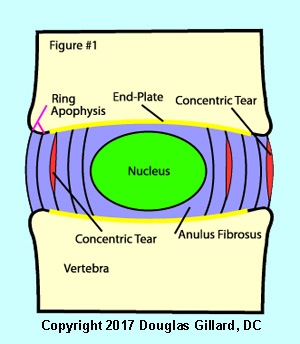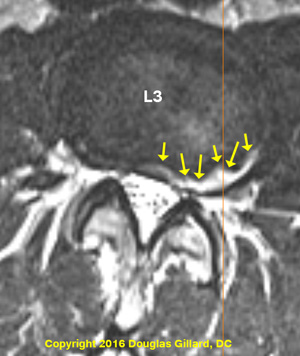Concentric annular tears
Radial Tears | Rim Lesions | HIZ Sign |
 Concentric annular tear, also known as circumferential annular tears, result from a separation or splitting apart of the lamellae of the annulus fibrosus. Notice how in figure 1 the lamellae have split apart and in inflammation has occurred. If this occurs in the outer one third of the disc, which of course has the nociceptive fiber (pain sensors), it could result in significant chronic low back pain.
Concentric annular tear, also known as circumferential annular tears, result from a separation or splitting apart of the lamellae of the annulus fibrosus. Notice how in figure 1 the lamellae have split apart and in inflammation has occurred. If this occurs in the outer one third of the disc, which of course has the nociceptive fiber (pain sensors), it could result in significant chronic low back pain.
Concentric tears are frequently seen in the middle and typically occur in the outer 1/3 of the anulus; they are rarely seen in the inner anulus.
It is believed that trauma is the cause of concentric tears, especially from torsion over-load injuries, such as swinging a golf club, throwing a discuss, or maybe even a "side posture" chiropractic adjustment.
Since the outer 1/3 of the anulus is well innervated (has pain fiber and can feel), a disruption in this region has the potential to be extremely painful. Again, as with all annular tear, why this injury is so painful in some and not painful at all and other people is unknown.
Technical Stuff!
Why do these concentric tears occur? Research has indicated that for reasons yet unknown, the lamellae lose their ability to adhere or ‘stick together’. This loss of adhesion between the lamellae is called ‘delamination’.
In 1997, Vernon-Robert et al. conducted one of the very few animal studies on induced concentric anular tears. They discovered that ‘delamination’ always proceeds a full-blown concentric tear (6). It is still unclear whether this process is the result of natural aging, pathological degeneration, trauma, or a combination of each.
Interestingly, animal studies have found that induced concentric tears do NOT stimulate severe disc degeneration like rims lesions do (26). However, they do "mess up" the biomechanics of the motion segment, which in turn results in a thickening of the lamellae and a general stiffening of that motion segment. To this end, Fazzalari et al. demonstrated that an induced concentric tear will cause a marked loss of motion in that motion segment and cause subchondral bone thickening adjacent to the tear (26).
Other research indicates that these tears do not seem to be associated with aging or degeneration, for they are seen in equal numbers in both the young and the old (3). These tear are the most commonly seen anular tear (6) and are seen in both the anterior and posterior regions of the disc with equal frequency; except at L5/S1 where they are more common in the posterior of the disc (3).
concentric tears: MRI appearance
 Concentric annular tear are really only visible on the axial views of MRI. In other words, you need to be able to look down on the disc in order to see the separation of the lamellae. and of course they are not visible and radiographs (x-rays) or even CT scan.
Concentric annular tear are really only visible on the axial views of MRI. In other words, you need to be able to look down on the disc in order to see the separation of the lamellae. and of course they are not visible and radiographs (x-rays) or even CT scan.
The figure left demonstrates a very "unusually" large concentric annular tear in this incredibly symptomatic patient who suffered chronic back and "referred" lower extremity pain.
Note that this is not a gadolinium-enhanced MRI! This is a regular T2-weighted image which demonstrates a wicked, rip-roaring inflammation process within this patient's L3 disc.
Another important thing to consider when you see a concentric annular tear: often times, there is a full thickness radial annular tear associated with it. It is rare to see the radial annular tear component of this, for the inflammation occurs in the outer portion of the disc only where the blood vessels are.
Also remember that concentric annular tears may result in the high-intensity zone finding (HIZ), which was studied by Ito et al. [19] Specifically, these researchers noted that the HIZ sign was in fact produced by the junction of a full thickness annular tear with a concentric annular tear. The radial tear allow some nuclear material to inter into the outer anulus and set up and inflammatory reaction. This inflammatory reaction in combination with newly formed, vascularized granulation tissue, results in the MRI finding for HIZ.
Take Home Message
Just remember that just because you see a concentric annular tear, or any annular tear for that matter, on MRI does not always mean that it is the cause of your chronic low back pain. It's only a piece of the puzzle of pain. The only way to really tell, is to undergo provocative discography (see my discography page) and you never want to do that unless you're absolutely at the end of your rope and ready to try interbody fusion.
Radial Tears | Rim Lesions | HIZ Sign | Anular Tear Home
References:
3) Osti OL, Vernon-Roberts B, et al. “Annular Tears & Disc Degeneration” J Bone Joint Surg [Br] 1992; 74-B:678-82
6) Vernon-Robert B, et al. “Pathogenesis of Tears of the Anulus”, - Spine 1997; 22(22):2641-46
19) Ito M, et al. “Predictive signs of discogenic lumbar pain on MRI with Discography correlation.” – Spine 1998; 23:1252-8
26) Fazzalari NL, et al. “Mechanical & Pathologic Consequences of Induced Concentric Anular Tears” – Spine 2001; 26(23):2575-2581
© Copyright 2002 – 2005 by Dr. Douglas M. Gillard DC - All rights reserved
